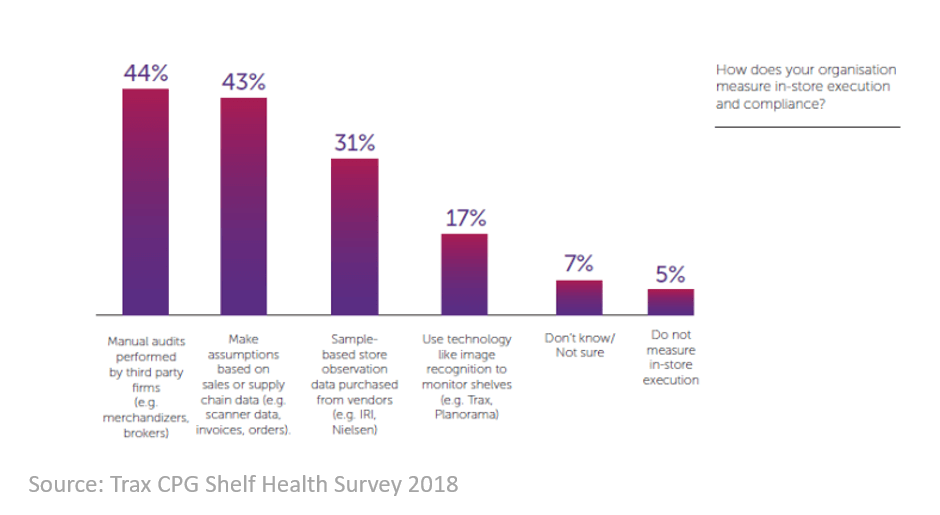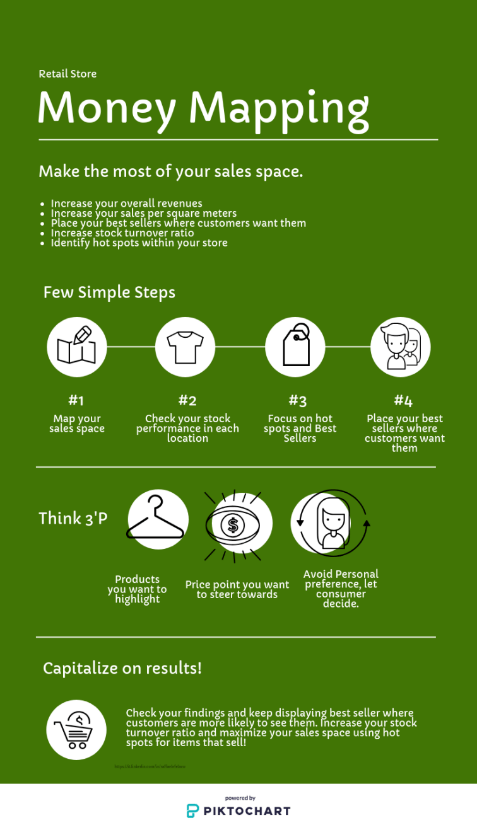When it comes to digital transformation, RFID (Radio Frequency Identification) has been the hype in retail for several years now. It has, however, been a bumpy road to success. In the past, stories of failed implementations and botched rollouts were far too common and kept many retailers from taking the plunge. Thankfully these days the picture is much more encouraging. We are now spoilt for case studies and examples of retailers having enormous success with the technology to digitise their inventory and processes for the modern retail environment.
So, what makes the difference between failure and success?
Ultimately it comes down to a combination of knowledge, technology and price. Improvements in all three of these areas have evolved the technology into a vital component of any digital transformation journey in retail. But as with any transformative project, getting the detail right is vital. The approach to implementation and suppliers you choose to engage with will have big implications on ROI.
A best-practise approach is easier said than done, so you need to surround yourself with a team of experts who have skin in the game and ensure the solution you choose to implement has the capabilities to lead your digital transformation for years to come.
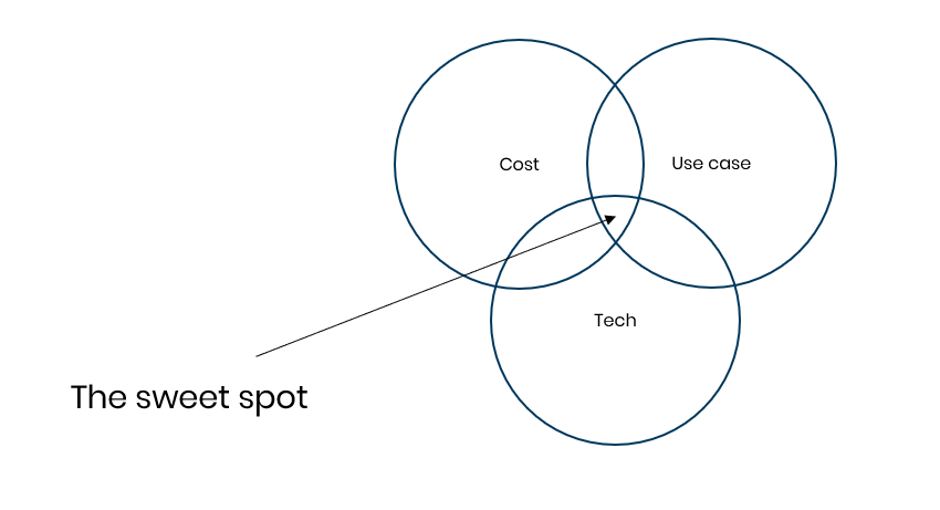
Our recommended 6 steps to digital transformation with RFID:
1. Understand the problems you want to solve and clearly define the KPIs
The first step in any new tech investment is to be sure that you have clarity around what problems you are hoping to solve. This will often require some hard-hitting questions and honest auditing of current processes and data to understand where you and your customer’s biggest pain points are. Customer feedback surveys are always a good way to gain insight into this.
What common retail problems can RFID solve?
- Stock inaccuracy leading to out-of-stock situations
- Poor product availability on salesfloors and webshop resulting in lost sales
- Labour costs and operational inefficiencies
- Reduction in excess/safety stock
- Inventory visibility and supply chain traceability
Luckily, these problems all have clear KPIs related to them and can be used as a great measurement tool to understand your current position and build a business case for the investment.
2. Choose a software partner that will help you achieve more
Once you have clearly defined RFID as the technology you want to implement, it is then vital to choose the right partners to go on your digital transformation journey with. Within the RFID market, there are generally three partner types – hardware, labels and software. The software component is the most important aspect as this must be able to process all the data, integrate with existing systems and empower employees with user-friendly applications to improve daily processes. Choosing the best-suited partners will make all the difference to ensuring you have a scalable and future proof solution for the next 5+ years.
What to look for in an RFID software partner?
- Credibility in the market – do they have proven RFID deployments with reputable brands in your sector?
- Future-proofed services – do they have a product roadmap that inspires innovation and constant improvement?
- Scalability and flexibility – does the solution fit your business needs and implementation roadmap?
- Industry expertise – do they have deep industry knowledge to understand your specific business requirements and help you think through these challenges?
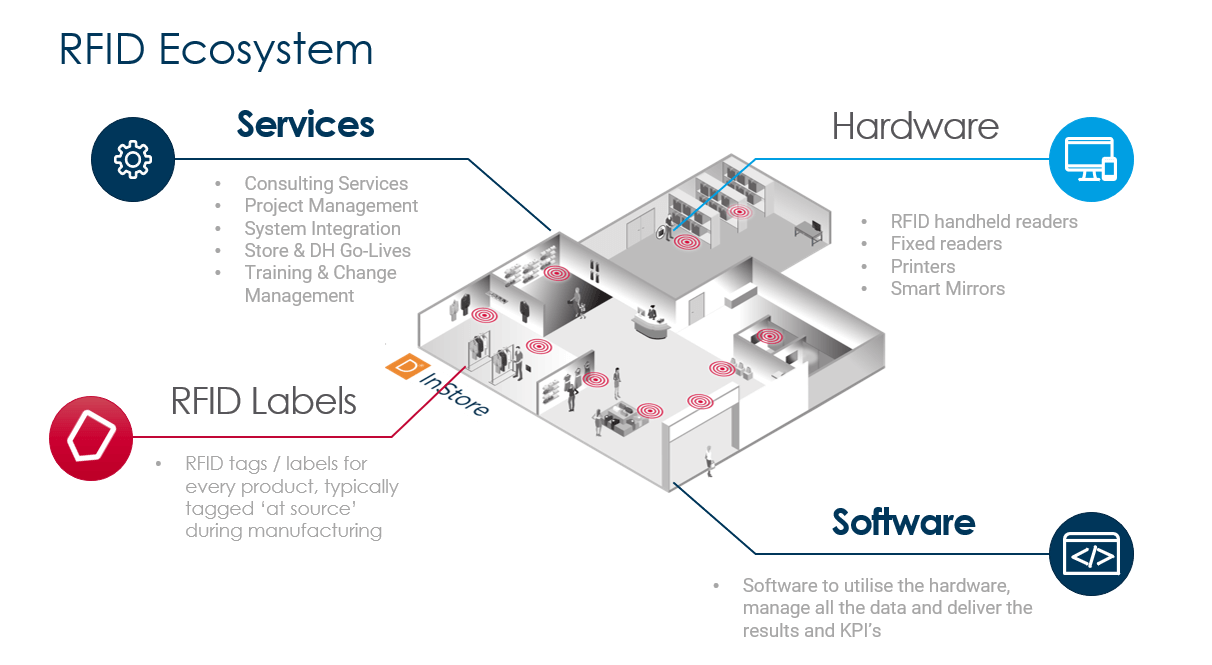
3. Trial the solution, prove the business case
Any digital transformation project requires buy-in from multiple departments and key decision-makers. The best way to achieve this is to prove the business case in a live retail environment. This is done through a ‘Pilot’ process whereby the solution is tested in around 3-5 live stores, allowing for the critical KPIs to be assessed and to gain a clearer understanding of the implications for store processes. With SaaS-enabled solutions, this process can be done more efficiently through the use of cloud-hosted mobile solutions, essentially making them ‘plug & play’.
What does the pilot process involve?
-
Tagging party of all items in Pilot stores with RFID labels
-
Product Master Data uploaded to SFTP (or FTP)
-
Training of store associates
-
Use of handheld readers and mobile app to perform daily store operations
-
Daily KPI tracking to analyse results:
- Improvement in stock accuracy
- Improvement in on-floor availability
- Increase in sales
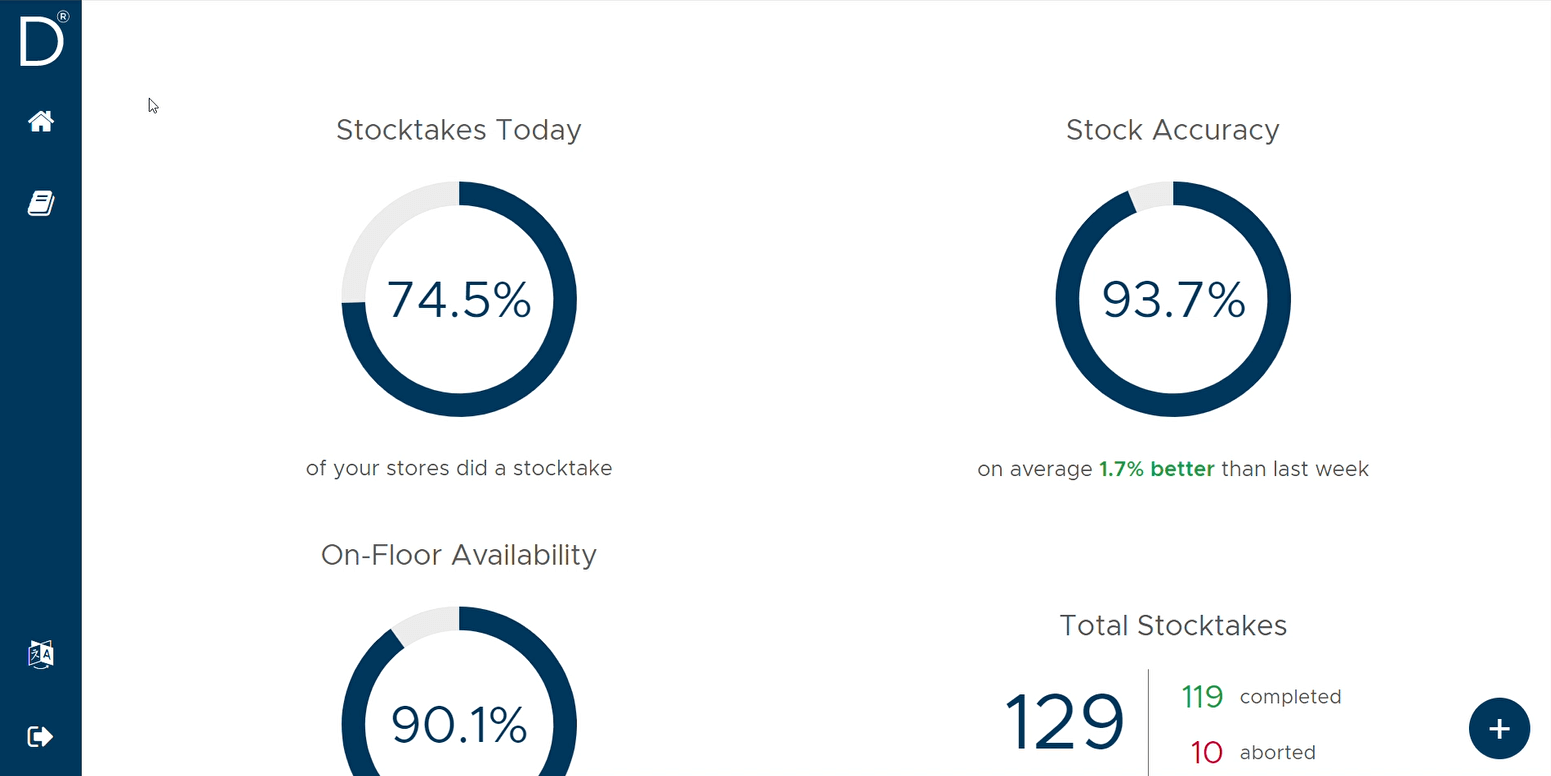
4. Store rollout with speed for immediate ROI
Although it seems attractive to enable all of the features and RFID-enabled services in one go, and undergo a digital transformation overnight, the reality is often different. Instead, retailers should approach implementation in phases to manage the changes in process and IT requirements. A best-practice approach to RFID implementation should focus on improving the fundamental processes that will bring the most immediate ROI to the business. These processes include stocktakes and replenishment to significantly increase stock accuracy and on-floor availability within stores. Improving these two KPI’s generally results in a direct sales uplift of 5-10%. From there, you can re-invest returns back into the continuous enablement of RFID throughout your business.
What elements are most critical to a successful store rollout?
-
Speed and ease of implementation
- New innovations such as Smart Shielding removes the need for physical shielding installations – saving time and money.
- SaaS-enabled platforms allow for scalable pricing models and cloud-hosted solutions.
- Open APIs allow for easy system integration with ERP
-
Support services
- Training to educate staff on the changes in daily processes
- Customer success and support to maximise the use of the software
-
Change management leadership
- Ensuring you have a dedicated team to oversee the rollout
5. Full omnichannel enablement
After securing the foundations of stock accuracy and on-floor availability in stores, the next step is to connect the online and offline business. Omnichannel services such as click & collect (aka BOPIS) and Ship-From-Store are expected in the modern retail environment as consumers demand to shop anywhere, anytime and any way they want. However, it’s important to ensure you can deliver on these retail experiences so that customers don’t end up disappointed. Enabling this requires connecting inventory from your store networks with your distribution centres and webshop to create a single and transparent view of stock.
What’s required for Omnichannel retailing?
- Transparent view of stock across all stores made available to the online store
- Automate warehouse processes with RFID tunnel and outbound processes
- Offer new services such as click & collect, ship-from-store etc.
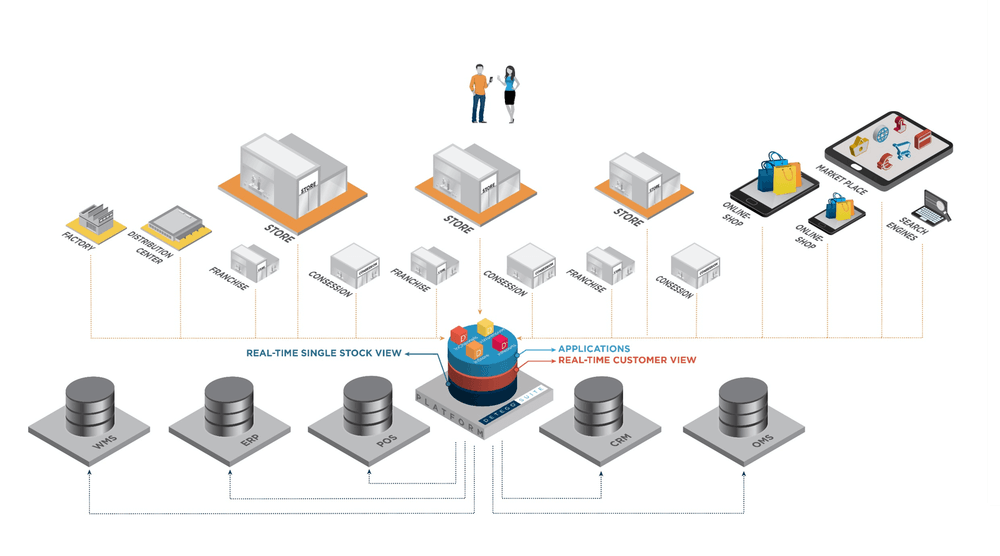
6. Unlock the true power of RFID with new retail experiences
Stock accuracy, product availability and omnichannel services are synonymous with RFID in retail and should always be the focus of any digital transformation utilising the technology. However, there is also an unlimited amount of untapped data and potential that is a sitting gold mine once you have RFID implemented throughout the supply chain. New solutions for consumer engagement and artificial intelligence engines can now be utilised to provide new services, experiences and insights for retailers and consumers alike.
What new innovations can be enabled?
Interested in discussing your RFID Journey? Talk to the experts.
At Detego we know retail and we know RFID. This combination has enabled us to develop the most innovative RFID software solutions on the market, alongside major global fashion brands. With RFID now on almost every retailer’s roadmap, we have the answers for any step of the journey, anywhere within your operations.
Everyone has to start somewhere, which is why we have out-of-the-box solutions to quick-start your RFID journey. Alternatively, if RFID is well and truly ingrained in your business, then talk to Detego about how we are using AI and innovative new practices to take real-time decision making to the next level.
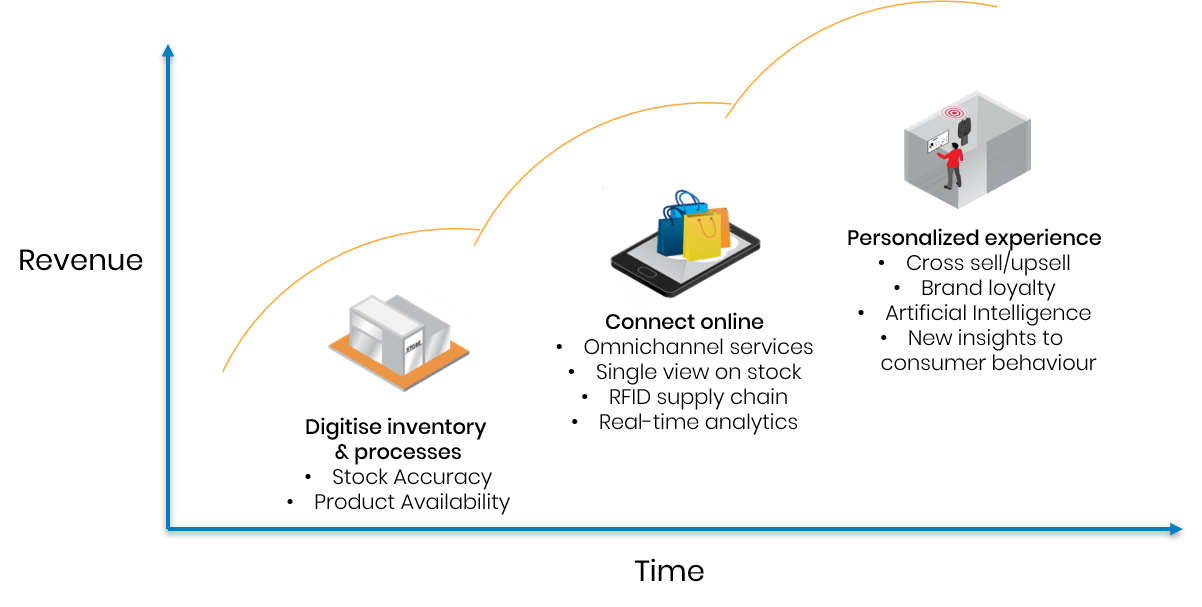
Want the latest retail and retail tech insights directly to your inbox?
Visual Merchandising’s Data Problem
Visual merchandising is one of the ‘dark arts’ of retail. For the uninitiated, it’s the practice of designing visually appealing sales floors and store fixtures that attract customers and ultimately sell the products on display. It’s a subjective and artistic means of delivering a concrete KPI – sales.
One of the challenges of visual merchandising is data, experimentation & design is all well and good, but not if you have no way of knowing what does and doesn’t work. Sales data is always a good place to start, but there are so many other factors at play that it’s often unwise to attribute visual merchandising to an increase or decrease of sales to a single product. You have to go one step further…
What is Money Mapping?
So, how do you measure the sales performance of a store based on its layout and design?
First, you map out the sales floor with the exact location of products. Then you break the map of the store into ‘zones’, typically around certain fixtures, shelves and displays. These zones can consist of several different items, grouped by either category or style depending on the design of the store.
You then collate the sales of every item in this zone and compare it to others in the same store. The result? An impression of shop floor sales broken down by areas of the store.
This is called ‘Money Mapping’ and allows retailers to visualise and analyse which areas of a store are ‘hotspots’ and which are ‘cold’ in terms of sales. This gives an initial view of which areas and fixtures are selling products and which aren’t.
To account for other external influences on sales, best practise is to swap items between fixtures or observe a ‘money map’ over a long time, as collections and merchandise changes between seasons. This way, if the localised sales data remains relatively similar even after products have rotated, then it’s clear the design or locations of the fixture is having an impact.
What are the benefits of Money Mapping?
- Insight on consumer experience
- Provides valuable data for visual merchandisers
- Breaks down areas of sales floor by sales performance
- Can be used to optimise store layout
- Drives Sales
- Can compare Product Placement & Visual Merchandising
- Can be used to conduct A/B tests
This all sounds great, so why doesn’t every retailer and every store do this already? The simple answer – the process of matching the sales data to specific locations on the sales floor, manually for every item and every store, is logistically a big ask. This means, if this can be done at all by visual merchandisers, it can only be done in a small number of stores.
How does AI change money mapping?
So how can we solve this data problem for visual merchandisers and make ‘Money Mapping’ easier and more accessible for retailers?
The first issue is having an accurate map of a store which includes exactly where every single item is sold from. Traditionally this would have to be done manually, and then have the sales data of items cross-referenced with their location in a store.
The solution: Using RFID (Radio Frequency Identification) and AI localisation techniques, we can now create a map of a store as part of the daily or weekly stock count.
This is done by adding ‘reference’ RFID tags into the store. Small tags just like ones that go on products are placed on fixtures and walls in the store. Because these never move, we can use the signal strength (relative to the fixtures) from stock counts to map exactly where items are in the store and what items they are grouped with.
This location info is then integrated with data from point of sale to generate an automated Money Map of a store, as part of the regular reporting and analytics function of the store. This can be done for as many stores as desired. With the data collection automated, visual merchandisers can focus on using the data to optimise product placement and store design across stores.
With larger data sets to work with, this also opens up the potential for more detailed analysis and experimentation such as A/B testing product combinations and store layouts!
What’s the process for AI Money Mapping?
- Attach reference RFID tags to walls and fixtures within the store
- Perform regular RFID stock takes as normal
- Software uses machine learning to ‘map’ out item locations within the store
- Integrate point of sale data with RFID software
- Software produces ‘heat map’ of the store based on sales
- Visual merchandisers can use data to inform strategy and measure results
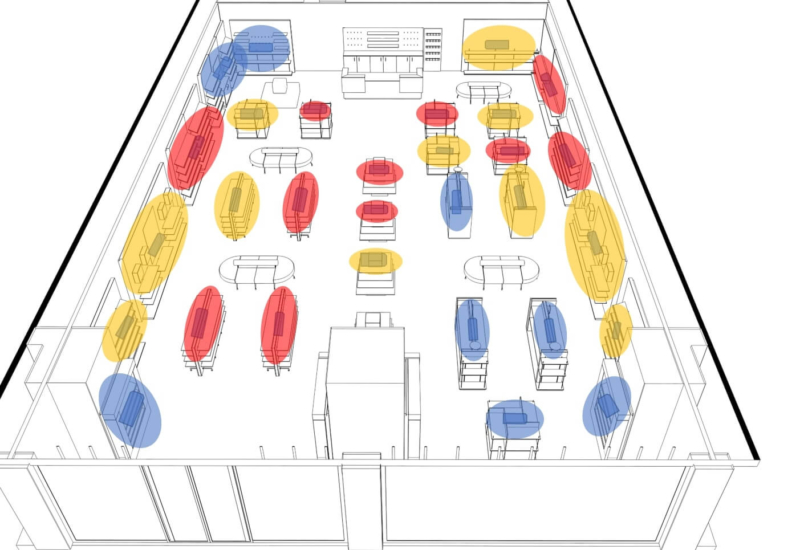
Conclusion
Visual merchandising is a subtle but valuable process for retailers. Done properly it has a huge impact on both sales, customer experience and brand image. The only problem with this is visual merchandisers often don’t have enough data to measure performance and identify where their attention is needed most. The data they can collect is either time consuming, expensive or inaccurate.
Artificial intelligence changes the game for visual merchandising. By utilising RFID tags and Machine Learning, it is possible to ‘map out’ the location of items in a store, and more importantly, the sales distribution of the shop floor. These ‘Money Maps’ tell visual merchandisers what areas of the sales floor are ‘hotspots’ for sales and which are underperforming. Using this data, they can then focus their attention on improving the design or layout of certain areas.
Additionally, with this data stores can look to leverage their sales hotspots either by prioritising the best locations for best-sellers, high-value items or items that are due to go out of season.
Either way, AI-enabled Money Mapping is another important evolution in retail data and analytics. Providing retailers with unprecedented insight into exactly what goes on in Brick and Mortar Stores.
Want the latest retail and retail tech insights directly to your inbox?
Artificial intelligence, the future of smart retail or another empty buzzword?
Artificial intelligence is the poster child for emerging or ‘new age’ smart technologies. Whilst it’s easy to get carried away with ideas of intelligent robots, AI mostly involves intelligent automation systems. This means computer systems that can process and respond to information by themselves, and even learn and self-correct better ways of doing so over time. AI is a broad spectrum, however, and the complexity and ‘intelligence’ of such systems can vary.
AI’s main use for retailers is to automate analysis and decision making
Because AI is still in relative infancy for retail, a large proportion of its use cases for the industry are still being developed and established. We have already seen a strong uptake in AI for customer intelligence in the form of online chatbots and product recommendation engines.
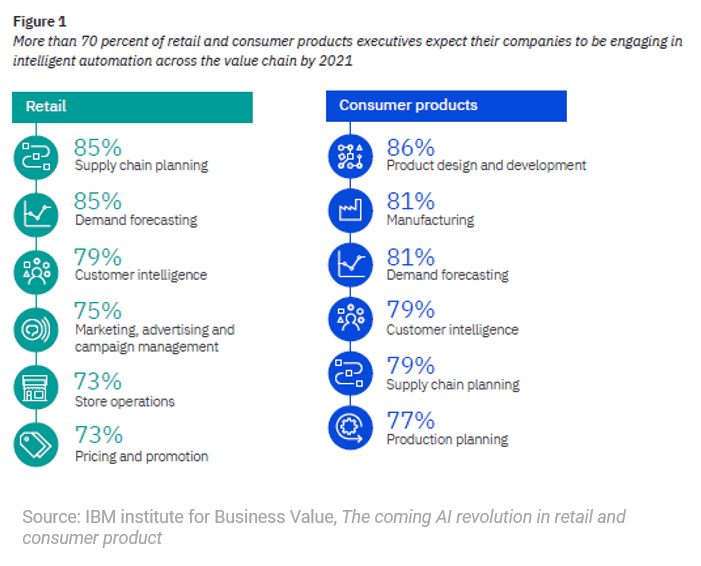
The other areas of potential, namely optimisation of business processes like supply chain planning, demand prediction and store operations, are beginning to take shape but all share a common problem – they need large amounts of data. This has been the main thing holding AI back in certain areas of the retail value chain, but by utilising another technology becoming increasingly common in the industry, this could all change…
RFID in retail, the story so far:
If the ‘AI revolution’ hasn’t really taken off yet, the RFID one is well underway. RFID is used in retail to track and manage merchandise, on a single item-level, with far greater detail and accuracy than traditional systems can manage. The key benefit of RFID for retailers is an accurate and single view of stock across the entire business and its supply chain.
Naturally, RFID systems produce a huge amount of data for products, both in the supply chain and in the individual store. If only there was something that could process all that data…
AI meets RFID: The perfect match
Combining the large amount of item-level data RFID produces with the automated processing power of AI is the natural next step for retail technology.
The key to doing this is each use case adding value or actively solving a problem. At Detego we often talk about ‘avoiding data for the sake of data’ so when using AI to process such data, producing actionable insights and recommendations is vital.
So, what can we do by utilising AI with RFID, and why should retailers care?
So far, the key areas RFID-driven AI automation offers value to retail operations are assisting store staff, assisting customers and optimising inventory management on both a single store scale and across entire store networks.
Our Data Science team are developing solutions for the following use cases, which we will explore in detail in future articles:
Webinar Recording: Combining AI and RFID Taking Retail Inventory to the Next Level
Artificial intelligence (AI) is becoming increasingly utilised within the retail industry. One of the main challenges with the technology is having enough relevant data to be utilised or ‘fed into’ an AI system. With Radio Frequency Identification (RFID) providing huge amounts of accurate item-level data for merchandise, the two are a match made in heaven.
This webinar cover AI’s applications for stock optimisation and how machine-learning can ensure products are always in the right place at the right time, including:
- AI-driven, automated planograms for optimised product availability
- Visual merchandising and ‘Money mapping’ in stores to monitor and increase sales.
- How RFID stock-takes and AI pick-lists combine to make replenishment faster and more accurate than ever
- How machine learning smart fitting rooms are bringing accurate cross-selling into the physical store
- Using AI for demand prediction and stock optimisation across store networks
The retail environment has never been more demanding than it is today, thanks to fierce competition, the growth of e-commerce, and consumers’ high expectations for seamless shopping experiences. It’s a situation made even more difficult by a lack of inventory visibility, the complexity of supply chains and the sheer variety of products brands are faced with.
While retailers have access to a growing number of solutions to these issues, RFID (Radio Frequency Identification) is the only one that’s proven to consistently meet retailers’ needs for leaner processes, accurate inventory and real-time data analytics.
This webinar covers:
• The five most important needs identified by retailers and their effect on business
• How RFID-based systems and processes can be applied to solve each need
• What financial and operational benefits can be gained by doing so
• How retailers can further unlock the power of RFID to offer a truly seamless and connected shopping experience
The 6 Key Benefits of RFID in Retail
RFID (Radio Frequency Identification) uses radio waves to track and identify tags attached to objects. The tags contain electronically stored information and are counted or ‘read’ by either handheld or fixed RFID readers.
In many ways RFID is used in retail as an alternative to a barcode system (although it doesn’t have to replace barcodes entirely). The more advanced technology involved in RFID mean it has a far greater level of accuracy and efficiency when it comes to counting inventory. As a result of this it has far broader applications in retail, most of which are built of off the back of this reliable inventory visibility.
By implementing RFID retailers can on average increase their revenue from 5-15% depending on the business. This on top of a margin increase of up to 1% and 10-15% lower working capital due to optimised inventory levels.
According to research in 2018, 69% of retailers cite a significant level of adoption, and this number is continuing to rise.
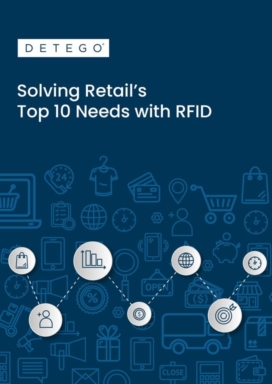
eBook
Solving Retail's Top 10 Needs with RFID
Discover how retail RFID is changing the industry for good. This eBook will guide you through the top 10 needs identified by retailers to ensure sustainable success in the modern environment. Explore the common challenges preventing retailers from achieving their goals and learn how applying smart RFID-based solutions delivers consistently good results.
Inventory Visibility

Due to the ease and accuracy of RFID stock counts, retailers using the technology can reliably achieve full item-level inventory visibility across their stores and supply chains. Crucially, due to the speed of RFID inventory counts, this can be achieved whilst actively reducing the labour intensity of operational processes. This accurate and up-to-the-minute inventory information is the backbone of so many of RFID’s uses in retail (including many of the points discussed below).
One crucial aspect of modern retail that relies on having accurate inventory visibility is Omnichannel retailing. With a complete and up-to-date view of stock across all channels, it is possible to open up the inventory of your entire store network to customers, providing a better customer experience and increasing sales.
Benefits of item-level inventory visibility
- Improved shipping accuracy
- Excellent baseline for advanced omnichannel retailing
- Produces more data for better insights
- Reduces inventory size (and therefore working capital) significantly
- Increased customer satisfaction from reduced out-of-stocks and a more connected experience
Increasing Product Availability

Ensuring a high product availability is vital to maintaining retail sales. Despite this, low on-floor product availability and out-of-stocks are an alarmingly common problem in the industry, causing unnecessary lost sales as a result of inefficient replenishment processes and stock inaccuracy. This latter cause is practically removed completely by RFID, with typical stock accuracy being increased to 99% from the standard 60-80%.
Additionally, RFID platforms provide an unbeatable basis for efficient and reliable replenishment processes. The main advantage these platforms have is the item-level and real-time inventory visibility gained from regular 99% accuracy stock counts.
How does RFID increase product availability?
- Makes regular cycle counts possible with efficient RFID stock reads
- Removes stock inaccuracy (from 70-80% to 99%)
- Creates complete item-level view of stock between both backroom and sales floor
- Item visibility makes replenishment easier and more accurate
- Real-time view allows for replenishment alerts for when items/sizes are running low
- Item-level data from RFID allows for advanced, even AI-assisted planograms for individual stores
Supply Chain Traceability

We’ve discussed the difference item-level visibility makes for stores, but when it comes to supply chains the benefits are just as great. With RFID, inbound and outbound reads become far easier, and are done on an individual item level rather than SKU (stock keeping unit). This means each item is accounted for at each step of the supply chain, rather than just shipments or boxes.
This level of stock visibility also drastically reduces the rate of shipping errors or picking mistakes as they are detected by RFID readers and corrected by warehouse staff during exception handling or outbound reads.
Additionally, the location or status of items and shipments are visible in real-time, so stores and DC’s can easily track shipments and know exactly what they will be receiving. This makes any individual item fully traceable, as time and dates of when the item passed each read point in the supply process can be stored.
Benefits of RFID in the supply chain:
- Item-level visibility across entire supply chain
- Trace items against individual shipments
- Smoother operational processes
- Track shipments for delivery
- 100% inbound and outbound shipping accuracy
Increasing Process Efficiency

The difference in process efficiency from using RFID in retail is extensive, at every end of retail, be it the factory or the shop floor. An RFID reader, regardless of whether its fixed or a handheld, can read hundreds of individual items at once. Crucially though, as each item has a unique ID, they can never be read more than once. The signals also do not require line of sight to be read.
Naturally, this makes RFID inventory counts and inbound/outbound checks incredibly fast and reliable. In the case of store inventories, RFID has been found to reduce cycle count times by a staggering 96%. This therefore means they are far more convenient to perform and can be done multiple times in a week rather than a year.
Processes transformed by RFID:
- Cycle counts/inventories
- Fast & Efficient Inbound & Outbound reads
- RFID-enabled picking and packing
- Mobile guided replenishment from backroom to salesfloor
Providing Real-Time Data

Analytics and data is one area that e-commerce is ahead of physical retail. This is largely due to the fact that everything online can be measured, whereas retailers don’t really know what’s happening with their stores and customers in any specific detail, and the stats and data they do collect are often historical and at risk of being outdated.
However, with RFID this can all change. The simplest and most effective use of the data allows retailers to better leverage their greatest assets; their products and their stores. Quality data and analytics can allow retailers to ensure merchandise is in the right place to be sold. Information on which stores are performing better or worse is a basic retail KPI, but with specific item data, RFID produces far more detailed insights. This includes how well individual items are doing in specific stores, right down to specifics such as which sizes of items are selling better where. Insights such as these are naturally actionable, meaning retailers can take steps to move or reinforce stock at specific stores.
Data insights and results possible with RFID:
- KPI based performance tracking
- Detailed merchandise data & Analytics
- Operational excellence
- Actionable recommendations
- Compliance tracking
- Eliminates reliance on historical data
- Predictive capabilities for inventory counts and merchandise management
Transforming Customer Experience

There are many effects of RFID in retail that go beyond simple operational benefits to actively improve the customer experience. At the most basic level, this includes things already mentioned like increasing product availability, offering convenient omnichannel services and freeing up store associates to spend more time assisting customers.
However, because of the real-time inventory visibility it provides, RFID can go way beyond this in terms of improving the customer experience. For example, with reliable and up-to-the-minute stock information stores can utilise technologies like chatbots or smart fitting rooms to assist customers with their queries, supply information about other items or sizes available and even cross-sell to customers in the store.
What ways does RFID improve the customer experience?
- High product availability
- Store associates have more time for their customers
- Convenient omnichannel services
- A connected experience between online and offline
- AI-powered chatbots delivering assistance and product information via mobile.
- Smart fitting rooms providing a hugely improved fitting room experience.
- RFID-enabled Point of Sale – including self-checkout services

eBook
Solving Retail's Top 10 Needs with RFID
Discover how retail RFID is changing the industry for good. This eBook will guide you through the top 10 needs identified by retailers to ensure sustainable success in the modern environment. Explore the common challenges preventing retailers from achieving their goals and learn how applying smart RFID-based solutions delivers consistently good results.
The retail industry has been subject to enormous change in recent years, a trend that looks likely to continue even now retail has found its feet in the digital age. This significant shift in the landscape coupled with the collapse of numerous household brands naturally created something of a panic in the industry and a fear an impending ‘retail apocalypse’. So, has this taken place and are brick and mortar stores heading toward extinction in the age of online shopping? The short answer: no. Retail sales, in general, are increasing, and whilst online sales are certainly growing at a faster rate than in stores, in the UK market Brick and Mortar stores make up roughly 84% of all sales, a trend that applies globally.
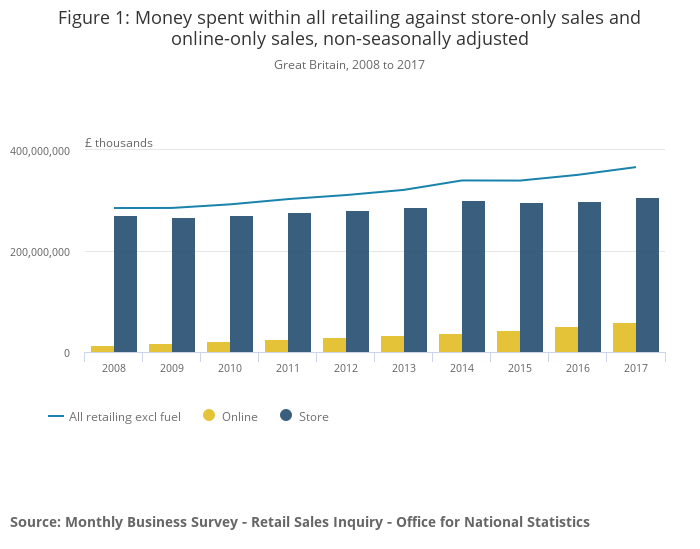
In fact, with the help of new technology, in particular, AI brick and mortar stores can take lessons from e-commerce and bring new innovations into the physical store. A study by Capgemini found that around 68% of pure-play online retailers have implemented artificial intelligence in some fashion, compared to only 10% of brick and mortar stores. Utilising new technology can often be the key to growth, so perhaps it’s no surprise that online retailing is growing at such a faster rate. This is beginning to change however, as physical stores are learning to adapt.
AI-assisted cross-selling in the store
The ability to cross-sell using AI is a huge strength of online retail. Online stores use machine learning to make intelligent and tailored product recommendations to customers while they are shopping This naturally increases sales, but does so relative to the quality of the product recommendations, hence the use of AI to perfect the process and make more successful recommendations. Brick and mortar stores have traditionally never been able to make use of cross-selling like this, having to rely on in-person customer service to drive sales. But as technology has improved, they can now make use of both.
The main reason for this is the emergence of chatbots as a mobile platform for in-store product recommendations. Whilst chatbots themselves originate from online, certain retailers now implement them in their stores to assist customers. Their primary function is often to assist customers if store associates are all occupied. Chatbots can help customers locate items, find more information on products and check stock availability, all through their smartphones. Intelligent AI-powered chatbots will then be able to recommend products similar to the item’s customers were searching for, not only increasing sales but improving the customer experience.
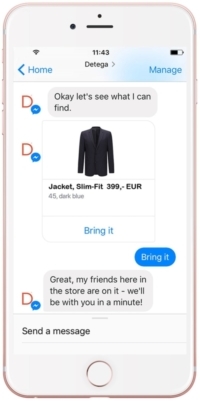
The fashion industry has taken this concept even further with the use of smart mirrors. Smart mirrors use advanced tagging technology (RFID) to sense the items that a customer brings into a fitting room. It will then display the products on the mirror and, like a chatbot, assist customers by providing information on other available sizes and colours and recommending products that are often bought with the ones being tried on. Most smart mirrors also have a feature that calls store staff to assist the customer, either providing face-to-face support or bringing the recommended items the customer has chosen to the fitting room. Smart fitting rooms are the epitome of the merger of the digital and physical in brick and mortar stores.
AI-powered in-store business intelligence
Artificial intelligence can also go a long way to revolutionising traditional brick and mortar store processes. One of the best examples of this is the use of AI assisted planograms. A planogram is essentially a plan of where items should be displayed on a shop floor to maximise customer purchases. In certain sectors such as fashion, planograms must be even more detailed and include the optimum display quantities of each different size and colour.
Artificial intelligence can revolutionise the planogram, using machine learning to constantly optimise not only the positioning of merchandise but the most efficient quantities of different articles to display on the shop floor. The advantages of this process being performed through AI are huge. Not only does it largely automate the process, saving time for staff, but it will constantly adapt and improve and can personalise and optimise the planogram on an individual store level.
The future of retail, online and in-store
To conclude, the impact of digital technology on the retail industry, in particular brick and mortar stores, has been significant but not actively catastrophic as many feared it would be. The emergence of ecommerce has gone from a threat to a strength for some physical stores. Not only has omnichannel retailing (something we did not have time to explore, but we go into detail on here) allied the different methods of shopping, but brick and mortar stores have now begun to incorporate certain technologies from online.
AI technology, originally something only online retailers could really utilise, is now finding its way into brick and mortar stores and improving both store processes and customer experience. We are also just scratching the surface of AI’s uses in retail and as more retailers choose to adopt the technology more benefits will be discovered. So, in reality brick and mortar stores are far from going extinct; they are in fact evolving and will continue to do so.
(Originally published on AI Business.com)
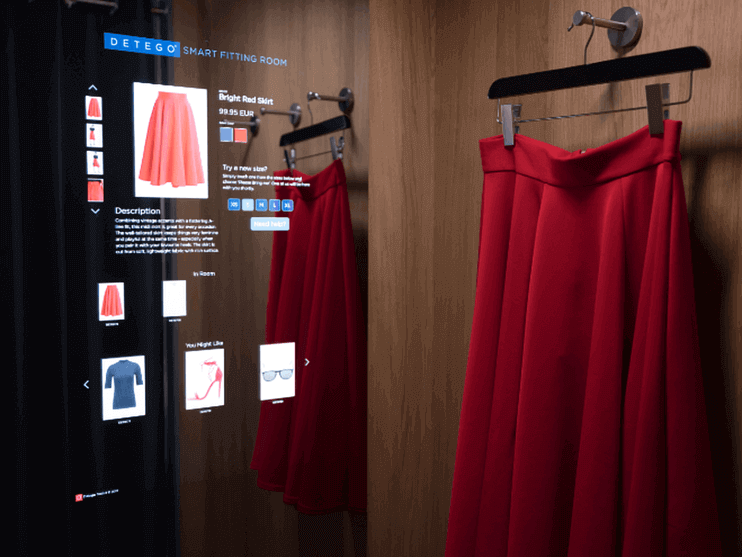
Did we spark your interest?
Planograms are a key part of running a retail store. In simple terms, they dictate the what, where and, the how many of products on the shop floor.
This article explores planograms, the challenges they present and how retails ongoing digital revolution along with artificial intelligence is changing planograms as we know them.
What is a planogram?
A planogram defines the location and quantity of products to be placed on display. They essentially function as blueprints for all merchandise within a store.
Alongside the visual merchandising element, planograms aim to optimise article availability and thus specifically stimulate sales.
So, a store planogram has two aspects:
1 – The Merchandising: which articles are presented on the sales floor and how (visual merchandising)
2 – The detailed quantities for individual colour and sizes (availability optimisation)
For example, a planogram might state where a formal shirt is displayed on the shop floor. The planogram will also state what quantities should be displayed, specific to different sizes and colours. So the planogram may state 3 mediums, 2 smalls, 2 larges and 1 extra-large are available on the shop floor, and so on.
Ideally, merchandising and planograms go hand in hand: customers are inspired by the presentation and then, their desired product is available in the matching size. The reality, however, often paints a different picture.
Planogram – Merchandising
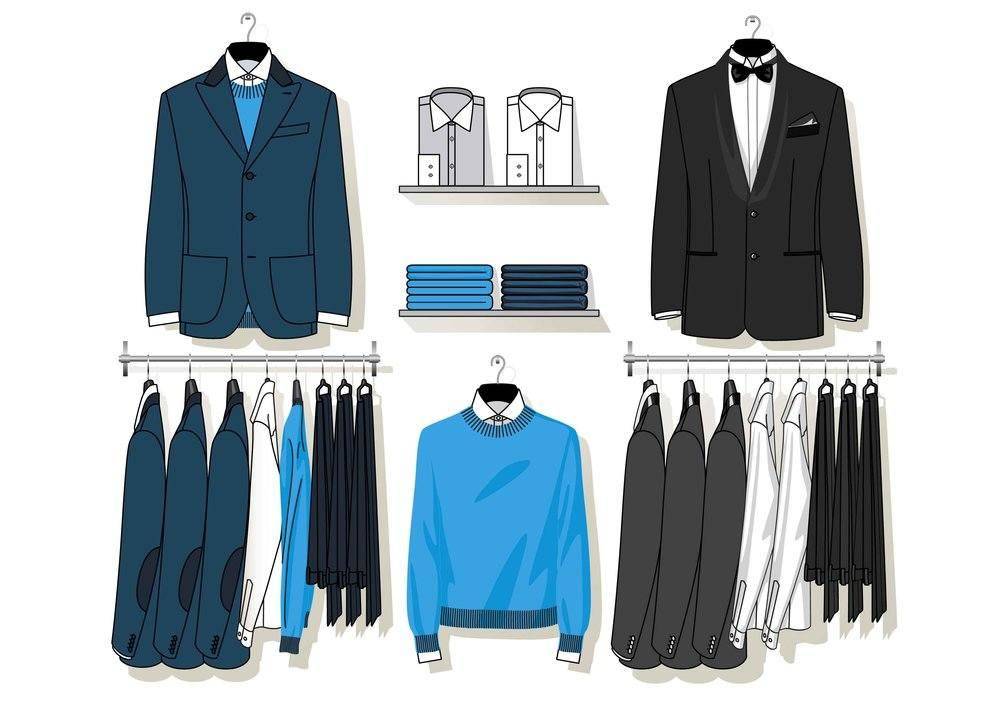
Planogram – Quantities and Priorities

Visually appealing and available in relevant sizes
What are the challenges of setting and maintaining a retail planogram?
Breaking this down, there are two questions that retailers face:
1) How do you define a planogram for my stores with a suitable size distribution?
The first question can be a challenge for retail depending on your definition of suitable. The reality is simply that manually creating and defining different size distributions for every single product is incredibly time-consuming and rarely worth the effort. This means generally stores will have a single set size distribution or ratio for every product in the store. This certainly could be worse, but it could (and can) be better….
2) How do you maintain the planogram on the shop floor? I.e. how to ensure that the products on the planogram are always on the shop floor
This, on the other hand, is a major challenge for retailers. What good is a planogram if it’s not adhered to? For example, if a planogram states that a size XL should be on the shop floor at all times but it is missing due to inaccurate or slow replenishment/refill, and a customer who needs that size can’t find it, more often than not that sale is lost.
There are two ways steps that go a long way to fixing this:
- Use a more specific and data-driven planogram in the first place (What we’re going to explore now)
- Having a better replenishment process in the store. (Like this one)
How does AI change the planogram?
Manual maintenance and adjustment of specific planograms is rarely a realistic option for retailers, especially when it comes to specific size distribution for individual products and stores.
By utilising artificial intelligence and machine learning procedures, it is possible to automate this process to define a precisely optimised size distribution for all articles across the store.
Not only does this save an enormous amount of planning time, but it also addresses the ongoing dynamics in individual stores. The self-learning system adapts to possibly changing conditions and continuously optimises the plan.
- Produces automated planograms based on sales data
- Produces optimised planograms for individual products
- Produces optimised planograms specific to the individual store
- Constantly adapts and optimised the planogram based on new data
AI planograms in action with the Detego platform
If this all sounds theoretical, its not.
During the operational process in the store, Detego InStore also supports the store personnel at several occasions: The software offers two parameters that provide information about article availability at any time and therefore represent important KPIs:
- On-floor availability: The percentage of all available articles that are currently displayed on the sales floor
- Planogram compliance: Provides information on how well the planogram with its individual size distribution is implemented on the sales floor
If one of the two parameters fall below certain threshold values, store staff needs to action: In addition to classic ERP systems, Detego InStore offers a finer level of granularity in the stores, by telling store staff that certain articles are available in the backroom but not on the salesfloor and therefore need to be refilled to comply with the predefined planogram.
Retailers benefit from a complete process for the planning and implementation. Another advantage: Refill advices in the app are sorted such that the search in the back room is made as efficient as possible by minimising walking routes.
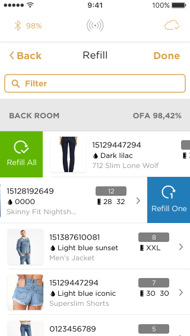
With AI planograms, shelf space is used for top sellers and is not wasted on sizes that are rarely or never bought. With its self-learning components, the Detego platform for the store makes a suitable proposal for all sizes and facilitates implementation in daily processes – including relevant KPIs for measuring performance. And if a certain size is not available in one store, the platform offers an exact inventory view of surrounding stores – ready for click & collect.
Benefits for retailers:
- Individually optimised AI planogram per store
- Efficient use of shelf space according to bestsellers per store
- Guided processes: from planning to refilling
- KPIs to provide insights on operational excellence per store – in real-time
Benefits for consumers:
- High on-floor availability for the locally popular sizes
- Positive customer journey
- Overall increased article availability through exact inventory data on the entire store network – including reservation options
Did we spark your interest?
Stocktakes are mandatory for retail businesses. With the right software, they can fulfil much more than just legal requirements. A real-time view on inventory provides the basis for high on-shelf availability and customer-oriented services.
The word inventory has its roots in the Latin “invenire” which means “to find something“. Anyone who has ever been involved in the process of a stocktake knows exactly how well this terminology fits. Finding something becomes particularly complex if the ERP system displays a different stock than what is counted on the sales floor and in the backroom. Usually, the products are written off as loss or attributed to shoplifting – which is a big problem especially in the fashion retail industry. But what if articles that could not be found are still in the store? And what about “positive differences” – meaning a surplus of stock?
The crux with inexact stocks
RFID-based article management with permanent inventory offers a very precise and reliable view on the stock-figures. Businesses are presented with real-time data, which the store personnel can access at any time. With this form of inventory, retailers get accurate stock information at any time and do not have to deal with numbers which may or may not be accurate at present. At the same time, the level of granularity can be increased: RFID technology makes it easy to determine which items are in the backroom and which ones are on the sales floor – the ideal starting point for a truly efficient refill process.
The optimal inventory cycle
The objectives of an intelligent inventory management process go far beyond the accounting requirements. A question that is frequently asked is “how often do we need to do that in order to achieve our targets”? Today’s systems, using AI and machine learning techniques, can automatically suggest the optimal inventory cycle, providing increased efficiency and store performance with positive effects on the overall profitability. A perfectly balanced inventory requires systems with an integrated and automated replenishment process, analytical forecasts on top sellers and the corresponding size breakdown.
Project implementation: a few hours. Stocktake duration: a few minutes.
It’s not only expensive to close down the store and hire additional personnel to carry out stocktakes – also the degrading accuracy has severe impact on the top and bottom line results of a store. For a quick start into exact inventories, intelligent software that drives article availability and inventory accuracy near 100% within just a few hours is now available –without having to invest heavily in a time- and resource consuming project. The quick-start system delivers a convincing performance in the store from day one and makes the roll-out across the entire store network easy and fast. The tedious and time consuming way of looking for articles that may or may not be there will be a thing of the past. Maybe it is time to find a new Latin word that is more suitable?
This webinar discusses intelligent planograms and how they enable an individual size distribution for fashion retail stores and make sure that products are available on the sales floor in the appropriate sizes.
It provide insights into how the self-learning system adapts to possibly changing conditions and continuously optimises the plan – with a direct impact on the store revenue.




